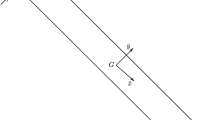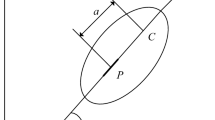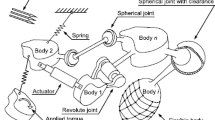Abstract
This paper presents stability and convergence results on a novel approach for imposing holonomic constraints for a class of multibody system dynamics. As opposed to some recent techniques that employ a penalty functional to approximate the Lagrange multipliers, the method herein defines a penalized dynamical system using penalty-augmented kinetic and potential energies, as well as a penalty dependent constraint violation dissipation function. In as much as the governing equations are not typically cocreive, the usual convergence criteria for linear variational boundary value problems are not directly applicable. Still numerical simulations by various researchers suggest that the method is convergent and stable. Despite the fact that the governing equations are nonlinear, the theoretical convergence of the formulation is guaranteed if the multibody system is natural and conservative. Likewise, stability and asymptotic stability results for the penalty formulation are derived from well-known stability results available from classical mechanics. Unfortunately, the convergence theorem is not directly applicable to dissipative multibody systems, such as those encountered in control applications. However, it is shown that the approximate solutions of a typical dissipative system converge to a nearby collection of trajectories that can be characterized precisely using a Lyapunov/Invariance Principle analysis. In short, the approach has many advantages as an alternative to other computational techniques:
-
(1)
Explicit constraint violation bounds can be derived for a large class of nonlinear multibody dynamics problems
-
(2)
Sufficient conditions for the Lyapunov stability, and asymptotic stability, of the penalty formulation are derived for a large class of multibody systems
-
(3)
The method can be shown to be relatively insensitive to singular configurations by selecting the penalty parameters to dissipate ‘constraint violation energy’
-
(4)
The Invariance Principle can be employed in the method, in certain cases, to derive the asymptotic behavior of the constraint violation for dissipative multibody systems by identifying ‘constraint violation limit cycles’
Just as importantly, these results for nonlinear systems can be ‘sharpened’ considerably for linear systems:
-
(5)
Explicit spectral error estimates can be obtained for substructure synthesis
-
(6)
The penalty equations can be shown to be optimal in the sense that the terms represent feedback that minimizes a measure of the constraint violation
Similar content being viewed by others
References
Arnold, V. I., Mathematical Methods of Classical Mechanics, Springer-Verlag, New York, 1978.
Bayo, E. and Serna, M. A., ‘Penalty formulation for the dynamic analysis of elastic mechanisms’, Journal of Mechanisms, Transmissions and Automation in Design 111, 1989, 321–327.
Bayo, E., Garcia De Jalon, J., and Serna, M.A., ‘A modified Lagrangian formulation for the dynamic analysis of constrained mechanical systems’, Computer Methods in Applied Mechanics and Engineering 71, 1988, 183–195.
Gear, W. C., Numerical Initial Value Problems in Ordinary Differential Equations, Prentice Hall, Englewood Cliffs, New Jersey, 1991.
Hecht, N. K., Browder, A. M., and Junkins, J. L., ‘Extremals of second order dynamical systems: an implicit integration process with energy rate matching’, Eighth VPI & SU Symposium on Dynamics and Control of Large Structures, Blacksburg, Virginia, 1991, proceedings to appear.
Isidori, A., Nonlinear Control Systems: An Introduction, Springer-Verlag, Berlin, 1989.
Joshi, S. M., Control of Large Flexible Space Structures, Springer-Verlag, New York, 1989.
Kurdila, A. J. and Narcowich, F. J., ‘Sufficient conditions for penalty formulations methods in analytical dynamics’, Computational Mechanics, accepted for publication, 1991.
Kurdila, A. J. and Menon, R. G., ‘A nonrecursive order n algorithm for the simulation of large flexible space structures’, AIAA Journal of Guidance, Control and Dynamics, in review, 1991.
Kurdila, A. J., Junkins, J. L., and Hsu, S., ‘On the existence of limit cycles for a class of penalty formulations of dissipative multibody systems’, in Developments in Theoretical and Applied Mechanics: Proceedings of the 15th Southeastern Congress on Theoretical and Applied Mechanics, Georgia Institute of Technology Publication, Atlanta, Georgia, 1990, pp. 757–765.
Kurdila, A. J., Papastavridis, J. G. and Kamat, M. P., ‘Role of Maggi's equations in computational methods for constrained multibody systems’, AIAA Journal of Guidance, Control and Dynamics 13, 1990, 113–120.
Meirovitch, L., Methods of Analytical Dynamics, McGraw-Hill, New York, 1970.
Nayfeh, A. H., Perturbation Methods, Wiley-Interscience, New York, 1990.
Nijmeijer, H., and van der Schaft, A., Nonlinear Dynamical Control Systems, Springer-Verlag, Berlin, 1990.
Oden, J. T., Qualitative Methods in Nonlinear Mechanics, Wiley Interscience, New York, 1990.
Papastavridis, J. G., ‘The Maggi, or canonical form of Lagrange's equations of motion of holonomic mechanical systems’, Journal of Applied Mechanics 57, 1990, 1004–1010.
Park, K. C., ‘Stabilization methods for simulation of constrained multibody dynamics’, to appear in the proceedings published by Computational Mechanics Publications, 1990.
Rasband, S. N., Chaotic Dynamics of Nonlinear Systems, Wiley Interscience, New York, 1990.
Serna, M. A. and Bayo, E., ‘Numerical implementations of penalty methods for the analysis of elastic mechanisms’, in Trends and Developments in Mechanisms, Mechines and Robotics — 1988, ASME, New York, 1988, pp. 449–456.
Walker, J. A., Dynamical Systems and Evolution Equations, Plenum Press, New York, 1980.
Zeidler, E., Nonlinear Functional Analysis and its Applications III, Springer-Verlag, New York, 1984.
Author information
Authors and Affiliations
Rights and permissions
About this article
Cite this article
Kurdila, A.J., Junkins, J.L. & Hsu, S. Lyapunov stable penalty methods for imposing holonomic constraints in multibody system dynamics. Nonlinear Dyn 4, 51–82 (1993). https://doi.org/10.1007/BF00047121
Received:
Accepted:
Issue Date:
DOI: https://doi.org/10.1007/BF00047121




